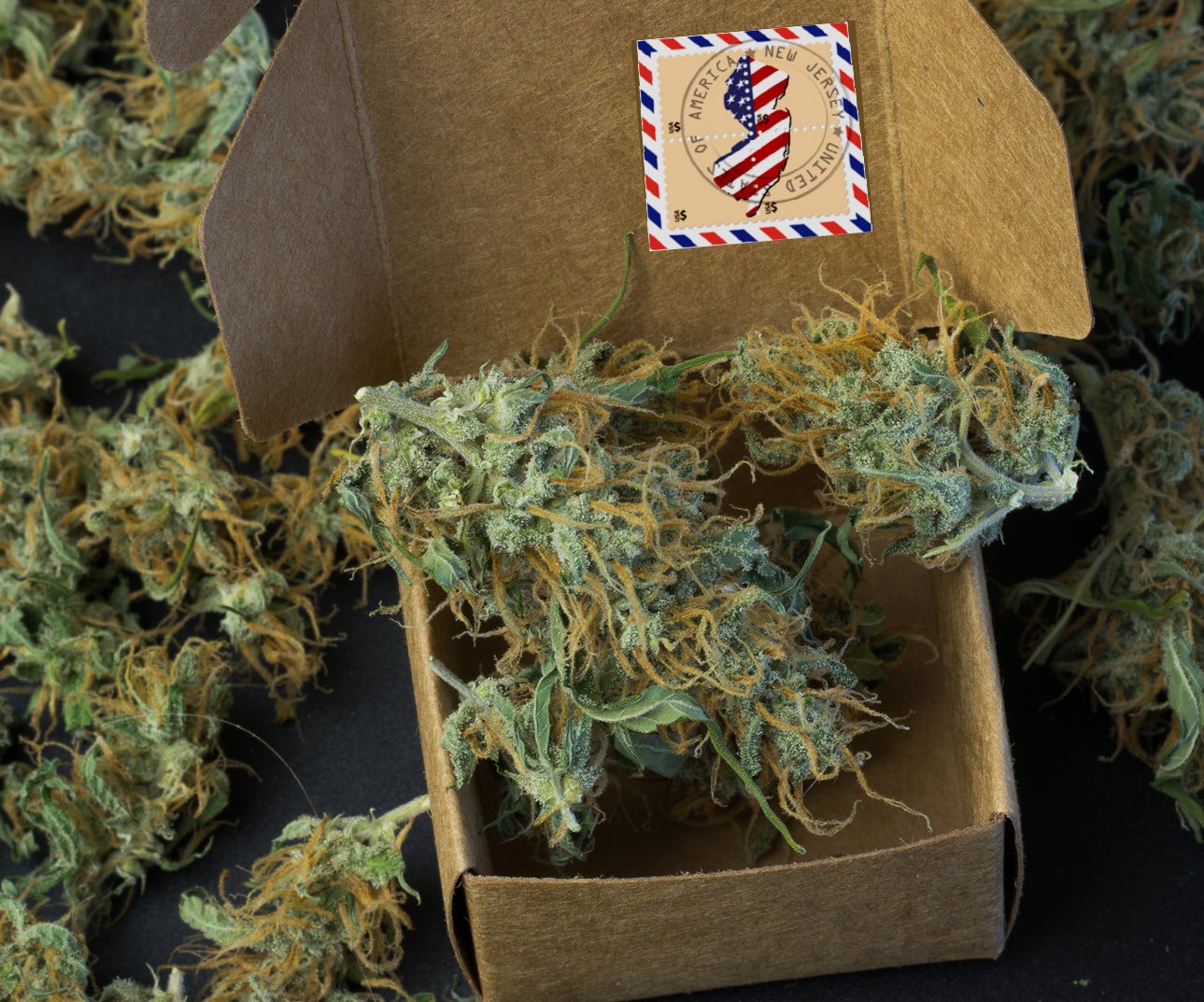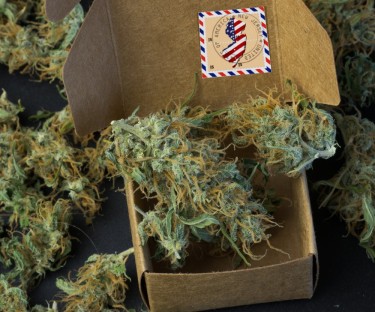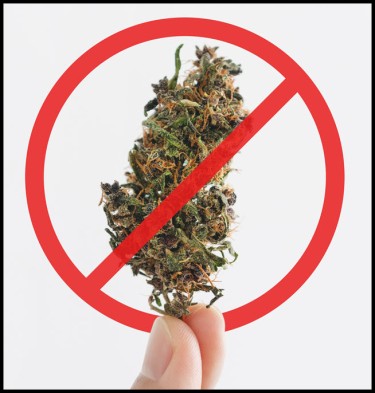Cannabis News
True or False, Moving Cannabis to a Schedule 3 Drug Means Sending Weed Through the Mail, UPS, or Fed Ex Is Now Legal?
Published
1 year agoon
By
admin

Certain cannabis industry leaders are optimistic that the federal government’s reclassification of marijuana from Schedule 1 to Schedule 3 of the Controlled Substances Act will clear the way for the interstate movement of cannabis goods. Legal experts in the marijuana industry, however, contend that this optimism is only partially justified.
Schedule 3 and Schedules 4 and 5 currently allow interstate commerce exclusively for drugs sanctioned by the U.S. Food and Drug Administration (FDA). Examples include anabolic steroids, ketamine, testosterone, Tylenol with codeine, as well as synthetic THC formulations like dronabinol, Marinol, and Syndros, prescribed to stimulate appetite in chemotherapy patients or those grappling with anorexia.
The question arises: Can products like cannabis flower, concentrates, THC-infused edibles, and other items available in medical marijuana dispensaries and adult-use retailers be eligible for interstate commerce?
Legally, the answer is negative unless these products secure FDA approval.
As emphasized by attorney Justin Brandt from the law firm Bianchi & Brandt in Scottsdale, Arizona, the crucial factor is FDA approval. He clarifies that possessing an FDA-approved cannabis product is the key to engaging in interstate commerce, drawing parallels with other Schedule 3 drugs like Tylenol with codeine. Brandt emphasizes that state-legalized medical cannabis, by itself, does not automatically attain the status of a Schedule 3 marijuana product. It remains distinct and separate, residing outside the jurisdiction of the FDA and the Controlled Substances Act, and therefore maintains its status as federally illegal.
Navigating Legal Complexities
While marijuana products lacking FDA approval would remain federally illegal, many observers anticipate that the rescheduling of the plant could lead federal authorities to be less inclined to target cannabis businesses engaged in cross-border sales.
In recent years, Congress has consistently included provisions in budget legislation barring the use of federal funds to crack down on state-regulated medical cannabis businesses. This legislative safeguard has played a significant role in the federal government’s hands-off approach to marijuana companies, even when classified as a Schedule 1 substance.
If marijuana is shifted to Schedule 3, legal experts and industry observers predict that federal intervention in compliant businesses adhering to state laws will be further reduced. Additionally, some believe that if states have established agreements permitting interstate commerce under specific conditions (as seen in California, Oregon, and Washington), the federal government will be even less likely to interfere under Schedule 3.
Eric Berlin, leader of the U.S. and global cannabis teams at the law firm Dentons, emphasized that FDA approval for cannabis products in interstate commerce would be unchecked. He suggested that states could potentially open up interstate commerce to some extent, and if Oregon and California chose to do so, there might be limited federal intervention.
Vince Ning, CEO of Nabis, a cannabis distribution company operating in California and expanding to New York, acknowledged that rescheduling might not alter the legal status of state-regulated marijuana products. However, he foresaw a potential shift in federal law enforcement attitudes and policies regarding state-regulated marijuana and interstate commerce.
The Intersection of State Agreements and Federal Oversight
In the event of rescheduling, there would be an immediate surge in positive sentiment favoring the promotion of interstate commerce, according to Ning.
California, Oregon, and Washington have enacted laws facilitating interstate commerce for licensed cannabis businesses, allowing the transport of THC products across state lines into other regulated markets. However, this is contingent upon the federal legalization of marijuana or its interstate commerce.
At the very least, the prospect of rescheduling prompts the federal government to reconsider whether it will permit or regulate interstate commerce noted Ning. He expressed confidence that federal authorities would likely refrain from interfering with marijuana interstate commerce as long as it aligns with state regulations.
Ning, however, issued a cautionary note. Given the oversaturation of many cannabis markets, he warned that legally imported marijuana from other states could worsen the challenging business climate if interstate commerce is not executed correctly. He highlighted the concern that an influx of California products into other markets could swiftly drive down prices, potentially harming local industries within specific states.
In response, Ning suggested that states facing such concerns might opt to impose import and export tariffs and interstate commerce taxes to safeguard their local cannabis industries from the potential adverse effects of price fluctuations.
Interstate Commerce Prospects: Assessing the Potential Impact of Marijuana Rescheduling
Ning pointed out that such regulations are not uncommon, as states also have their own laws governing the distribution of alcohol, which companies must adhere to.
“Each state has its own tax regulations when it comes to transporting liquor. If you intend to transport alcohol across state borders, you must work with specific distributors. Each state imposes different taxes and requires different sets of paperwork,” explained Ning. “Compliance with the regulations in each state is necessary, involving a significant administrative burden. However, considering the evolution of the market so far, it seems that the cannabis industry is likely moving in a similar direction.”
Hawaii is also navigating the complexities of federal marijuana enforcement. In June, the state passed House Bill 1082, allowing state-licensed companies to wholesale marijuana to cannabis businesses, even those situated on different islands. These regulations became effective on August 7, a crucial development as traveling between islands involves crossing federal waters.
Big Island Grown, based in Hilo, Hawaii, successfully conducted its inaugural inter-island transport to Green Aloha dispensaries on Kauai on September 1. Jaclyn Moore, CEO of Big Island Grown, emphasized that despite the passage of the Hawaii legislation, it explicitly warns cannabis businesses that state law does not override federal marijuana prohibitions.
When asked about her confidence that federal authorities won’t interfere with interisland marijuana shipments, Moore expressed uncertainty. She emphasized the importance of operating as compliantly as possible and exceeding compliance requirements, recognizing the federal focus on addressing issues within the illicit market rather than targeting highly compliant state businesses.
Bottom Line
The potential rescheduling of marijuana from Schedule 1 to Schedule 3 has sparked optimism among some in the cannabis industry regarding the prospect of interstate commerce. However, legal experts stress that the requirement for FDA approval may temper such optimism. While a shift to Schedule 3 could influence federal intervention, challenges, such as oversaturation and potential price fluctuations, underscore the need for careful execution of interstate commerce. The complex interplay between state and federal regulations, likened to those in the alcohol industry, highlights the evolving nature of the cannabis market. As states navigate these complexities, the success of the interstate cannabis trade hinges on compliance, regulatory alignment, and a nuanced understanding of federal priorities within the dynamic landscape of the burgeoning industry.
IS SHIPPING WEED ALREADY LEGAL TO DO? READ ON…
YES, IT IS PROBABLY LEGAL TO SHIP CANNABIS UNDER THE DCC SAYS PROF. MIKOS!
You may like
Cannabis News
Hemp and the New Senate Farm Bill
Published
38 minutes agoon
November 21, 2024By
admin
The U.S. Senate’s version of the Farm Bill finally landed this week. They’re calling it the Rural Prosperity and Food Security Act of 2024 (the “Senate bill”). The Senate bill follows on the House’s proposal, called the Farm, Food and National Security Act of 2024 (the “House bill”), offered in May. Neither the Senate bill nor the House bill would preempt state or Indian law regarding hemp or the regulation of hemp products. This means states and tribes will retain a lot of latitude in regulating hemp and hemp-derived products– which gets people fired up.
Aside from giving states some runway, the Senate bill and the House bill differ in key respects regarding hemp. Therefore, these august bodies must confer and reconcile their sundry proposals. That could happen in 2024, but seems more likely in 2025 when the new Congress convenes. As of this week, though, we finally have a framework.
The Senate Bill re-defines “hemp” and defines “industrial hemp”
Section 10016 of the Senate bill (“Hemp Production”) amends the definition of “hemp.” Hemp was defined in the 2018 Farm Bill and removed from the federal Controlled Substances Act (CSA), taking us on a truly wild ride. See: What Happened to Hemp? (“What Happened”). The Senate bill also gives us a definition for “industrial hemp.” Here are those definitions, with points of emphasis in bold:
(1) Hemp. The term “hemp” means (A) the plant Cannabis sativa L. and any part of that plant, including the seeds thereof and all derivatives, extracts, cannabinoids, isomers, acids, salts, and salts of isomers, whether growing or not, with a delta-9 total tetrahydrocannabinol concentration (including tetrahydrocannabinolic acid) of not more than 0.3 percent on a dry weight basis; and (B) industrial hemp.
(3) Industrial Hemp. The term “industrial hemp” means the plant Cannabis sativa L. if the harvested material (A) is only (i) the stalks of that plant, fiber produced from those stalks, or any other manufactured product, derivative, mixture, or preparation of those stalks (except cannabinoid resin extracted from those stalks); (ii) whole grain, oil, cake, nut, hull, or any other compound, manufactured product, derivative, mixture, or preparation of the seeds of that plant (except cannabinoid resin extracted from the seeds of that plant); or (iii) viable seeds of that plant produced solely for production or manufacture of any material described in clause (i) or (ii); and (B) will not be used in the manufacturing or synthesis of natural or synthetic cannabinoid products.
The new regime
Again, the definitional stuff in bold is what I want to emphasize.
First, the Senate bill keeps the THC threshold at 0.3 percent, which is an arbitrary number we’ve been advocating against for years. The Senate bill mirrors the House bill in this respect, though, so we are stuck with this, unless Ron Paul gets his way.
Second, the Senate bill keeps the 2018 Farm Bill’s total THC standard, including THCA. The House bill does this too. This was fairly predictable: in What Happened, I wrote that we could “expect the total THC standard to remain, which means that actual Delta-9 THC won’t be the only metric for calculating THC content.”
We’ve also explained on this blog that the 2018 Farm Bill and USDA rules mandate total THC testing on pre-harvest hemp batches, but do not mandate such testing on post-harvest hemp or hemp products. The Senate bill doesn’t change this paradigm, which means the “loophole” for gas station weed remains open. This proposal is a big win for opponents of the House bill’s “Miller Amendment,” which would narrow the definition of “hemp” to exclude intoxicating hemp-derived substances.
Third, the Senate bill introduces a new definition and framework for industrial hemp. The House bill does this too, albeit slightly differently. The idea here is to invite farmers to grow hemp for fiber and grain purposes, while freeing them from regulatory burdens with the Department of Agriculture and criminal exposure with the Department of Justice. More specifically, for “industrial hemp” growers, the Senate bill:
- removes background check requirements;
- instates “relaxed regulatory requirements” for sampling and inspection methodologies (which will need to be adopted by rule); and
- develops a certified seed program.
The Senate bill also makes any hemp producer ineligible to grow hemp for five years if that producer, “with a culpable mental state greater than negligence, produces a crop of hemp that is inconsistent with that license.”(Hint: use the seed program.) The proof standard here seems like it could be an issue, and even if anyone has been adjudicated as growing marijuana under the guise of hemp, Farm Bill ineligibility seems like a far-off concern.
Bottom line
The big takeaway for me is that the Senate bill leaves the door open for intoxicating hemp products, whereas the Miller Amendment to the House bill does not. Something’s gotta give. And it needs to happen soon, because we’re already long overdue. As I explained in a webinar last week, the Farm Bill deals with the nation’s entire food supply, not just hemp. Therefore, this is not like with the SAFE Banking Act, where we have a proposed law specific to cannabis that may or may not ever pass. The Farm Bill must pass, and soon.
Stay tuned and we’ll keep you updated on any major happenings. For more on this topic, check out our massive hemp and CBD archive, or these specific, recent posts:
Cannabis News
The Red Wall Blocking Marijuana Legalization in America, Real or Imagined?
Published
2 hours agoon
November 21, 2024By
admin

As the movement for marijuana legalization gains momentum across the United States, a significant barrier remains in place in many conservative states, forming what advocates and analysts have termed a “red wall.” This phenomenon highlights the stark divide between states that have embraced cannabis reform and those that continue to criminalize its use, particularly in areas where Republican leadership is firmly entrenched. This article will explore the current landscape of marijuana legalization, the factors contributing to this resistance, and the implications for consumers and advocates alike.
The Current State of Marijuana Legalization
Over the past decade, public opinion regarding marijuana has shifted dramatically. According to recent polls, approximately 68% of Americans support legalizing cannabis for recreational use. This shift has translated into legislative action, with 38 states and the District of Columbia allowing medical marijuana and 24 states legalizing it for recreational use. States like California, Colorado, and Illinois have set precedents with robust frameworks for both medical and recreational cannabis markets.
Despite this progress, a significant number of states remain resistant to change. As of 2024, there are still 20 states where marijuana is illegal for recreational use, many of which are governed by Republican majorities. This resistance is often attributed to a combination of political ideology, cultural attitudes, and concerns about public safety.
The Red Wall: A Political Barrier
The term “red wall” refers to the political landscape in conservative states where Republicans maintain control over both legislative chambers and the governor’s office—known as a trifecta. In these states, efforts to legalize cannabis face substantial obstacles due to party alignment and prevailing conservative values.
States such as Wyoming, Idaho, and Nebraska exemplify this red wall. Here, despite growing public support for legalization, lawmakers remain hesitant to advance legislation or allow ballot initiatives that would enable voters to decide on cannabis reform. The result is a patchwork of laws that leaves millions of Americans in conservative regions without access to legal cannabis.
Factors Contributing to Resistance
One of the primary reasons for the red wall against marijuana legalization is the deeply ingrained political ideology within conservative circles. Many Republican leaders view cannabis as a moral issue rather than a public health or economic one. This perspective is often rooted in traditional values that prioritize law and order over personal freedom.
Additionally, some conservative lawmakers express concerns about the potential societal impacts of legalization, including increased drug use among youth and impaired driving incidents. These fears can overshadow empirical evidence from states that have legalized cannabis, which often show no significant increase in youth usage or traffic accidents.
Cultural attitudes toward marijuana also play a significant role in shaping policy decisions in conservative states. In many regions, cannabis remains stigmatized as a dangerous drug associated with criminal behavior. This stigma can lead to fear-based policymaking that prioritizes prohibition over regulation.
Moreover, conservative communities may have strong ties to traditional industries such as agriculture and law enforcement that view marijuana legalization as a threat to their interests. These cultural dynamics create an environment where lawmakers are reluctant to support reform efforts that could alienate their constituents or undermine their political base.
Legislative Challenges
In addition to ideological resistance, practical legislative challenges further complicate efforts to advance marijuana legalization in conservative states. Many red wall states have stringent requirements for ballot initiatives or legislative proposals that make it difficult for advocates to gain traction.
For instance, some states require an exceptionally high percentage of signatures from registered voters to qualify for a ballot initiative. In Florida, a recent attempt to legalize recreational cannabis fell short of the required 60% supermajority needed for passage, despite receiving majority support from voters. Such hurdles can stifle grassroots efforts and limit opportunities for public input on cannabis policy.
Recent Developments in Red Wall States
Historically, ballot initiatives have been an effective strategy for advancing marijuana legalization in various states. However, this approach has faced increasing challenges in conservative strongholds. In North Dakota and South Dakota, recreational cannabis measures were defeated again in 2024 after previous attempts had also failed.
In South Dakota specifically, voters approved a legalization measure in 2020 only to see it challenged by state officials who argued it was unconstitutional. This led to protracted legal battles that ultimately stalled implementation efforts. Such experiences highlight how state officials can actively work against voter-approved measures when they conflict with prevailing political ideologies.
Legislative Efforts: Stalled Progress
In addition to ballot initiatives failing at the polls, legislative efforts in red wall states have also struggled to gain traction. For example:
-
Kansas: Despite growing support among residents for medical marijuana legalization, Republican lawmakers have repeatedly blocked proposals aimed at establishing a regulated medical program.
-
Kentucky: Efforts to legalize medical cannabis have faced significant hurdles in the state legislature despite bipartisan support among constituents.
-
Wisconsin: Governor Tony Evers has proposed measures to legalize both medical and recreational marijuana; however, these proposals have consistently met resistance from Republican-controlled legislative chambers.
These examples illustrate how even when there is public support for reform, entrenched political opposition can thwart progress.
Implications for Consumers and Advocates
Continued Criminalization
The persistence of the red wall means that millions of Americans living in conservative states continue to face criminal penalties for cannabis use. Individuals caught with small amounts of marijuana can face fines or even jail time disproportionately affecting marginalized communities.
Moreover, the lack of legal access forces consumers into unregulated markets where product safety cannot be guaranteed. This situation poses health risks associated with untested products and contributes to ongoing cycles of criminalization rather than promoting responsible use through regulation.
Economic Consequences
The economic implications of maintaining prohibition are significant as well. States that refuse to legalize cannabis miss out on substantial tax revenue generated from regulated markets. For instance:
-
Colorado: Since legalizing recreational marijuana in 2014, Colorado has generated over $1 billion in tax revenue from cannabis sales.
-
California: The state’s legal cannabis market is projected to generate billions annually in tax revenue—money that could be used for education, infrastructure, and public health initiatives.
In contrast, conservative states that uphold prohibition forego these potential revenues while also incurring costs associated with enforcing drug laws and managing related criminal justice issues.
Advocacy Strategies Moving Forward
Given the challenges posed by the red wall, advocates for marijuana legalization must adapt their strategies if they hope to make progress in conservative states:
The Future of Marijuana Legalization
As we look ahead, it is clear that overcoming the red wall will require persistent effort from advocates committed to changing hearts and minds within conservative states. While progress may be slow and fraught with challenges, shifts in public opinion suggest that change is possible.
The ongoing conversation surrounding federal rescheduling under President Biden’s administration could also influence state-level policies. If cannabis were moved from Schedule I to Schedule III under federal law—a move some speculate could happen under future administrations—states might feel pressured to reconsider their own prohibitive laws.
Ultimately, navigating this complex landscape will require resilience from advocates who understand both the political realities at play and the potential benefits of legalization for consumers and society as a whole.
Conclusion
The “red wall” against marijuana legalization represents a formidable barrier within many conservative states where outdated perceptions about cannabis persist alongside strong political opposition. As public opinion continues to evolve nationally favoring greater acceptance of both medical and recreational use advocates must adapt their strategies accordingly.
By building coalitions across diverse groups and focusing on education at the community level while pursuing incremental reforms where possible, advocates can work toward dismantling this barrier over time. The journey toward comprehensive marijuana reform may be long and challenging; however, with sustained effort and commitment from supporters across all sectors of society including those residing behind the red wall progress is achievable.
CONSERVATIVES BLOCKING CANNABIS BILLS?, READ ON…


https://www.marijuanamoment.net/researcher-asks-federal-court-to
-halt-dea-marijuana-rescheduling-hearings-over-allegations-of-illegal-proceedings-and-agency-bias/
When the Biden administration announced plans to reschedule cannabis to Schedule III, many cannabis advocates celebrated what they saw as a step toward legitimacy. I wasn’t among them. From the beginning, I’ve argued that Schedule III is nothing more than a sweet spot for Big Pharma – allowing them to maintain control while giving the illusion of progress. Cannabis doesn’t belong on the Controlled Substances Act at all, and frankly, the CSA itself is an outdated relic that needs to be abolished.
But even for those who embraced the Schedule III proposition, reality is about to hit hard. A researcher has just filed a lawsuit against the DEA, alleging multiple violations in the rescheduling process – from ignoring Native American tribes to sidelining small businesses. This is just the beginning of what promises to be a lengthy legal battle from all sides. Prohibitionists will fight to maintain strict control, while reform advocates will push for complete descheduling. Big Pharma, meanwhile, will work behind the scenes to ensure any changes benefit their bottom line.
The DEA’s rescheduling process was never going to be smooth sailing. Cannabis is too complex, too deeply woven into our culture and commerce to be neatly categorized under the CSA’s rigid framework. It’s a plant that’s been used medicinally and spiritually for millennia – trying to force it into the same regulatory box as synthetic pharmaceuticals is like trying to fit a square peg into a round hole.
There’s only one sensible path forward: complete descheduling coupled with a comprehensive national framework for legalization. Anything less will result in years of legal battles, regulatory confusion, and continued barriers to access. Those hoping Schedule III is just around the corner are in for a rude awakening. The lawfare is just beginning, and it’s going to be a long, messy fight.
Let’s look at how this legal battle is shaping up and why Schedule III may be dead on arrival…
David Heldreth’s lawsuit against the DEA marks the opening salvo in what promises to be a protracted legal battle over cannabis rescheduling. As CEO of Panacea Plant Sciences, Heldreth’s grievances strike at the heart of the DEA’s process, alleging multiple violations that could potentially derail the entire rescheduling effort.
The core complaints are substantial: The DEA failed to consult Native American tribes, despite the significant impact rescheduling would have on tribal law enforcement and health services. They’ve effectively shut out small businesses from the process, favoring larger entities already positioned for Schedule III licensing. Perhaps most damning, Heldreth claims the DEA deliberately excluded his company from scheduled hearings despite timely requests to participate, suggesting potential bias in the selection process.
These allegations come after a whirlwind of activity from the DEA. Following Biden’s directive to reconsider cannabis classification, the agency received over 43,000 public comments and scheduled hearings for December 2nd. However, only 25 participants were selected to testify – a suspiciously small number given the industry’s size and scope.
While Heldreth’s legal arguments appear sound – particularly regarding tribal consultation requirements and constitutional questions about DEA judge appointments – the judiciary’s historical deference to administrative agencies might prove challenging. Courts typically give agencies broad latitude in implementing federal law, making this an uphill battle.
But here’s the crucial point: whether Heldreth’s lawsuit succeeds may be less important than its role as a blueprint for future legal challenges. Prohibitionist groups like Smart Approaches to Marijuana (SAM) are already sharpening their legal knives, preparing to challenge every aspect of the rescheduling process. They’ve made it clear they’ll use every available legal tool to keep cannabis in Schedule I.
We’re likely to see challenges from multiple angles: constitutional arguments, administrative procedure violations, environmental impact concerns, and public health disputes. Each lawsuit, regardless of merit, will add months or years of delays to the process. Even if most fail, it only takes one successful challenge to throw the entire rescheduling effort into chaos.
Schedule III isn’t just facing a single legal battle – it’s staring down the barrel of a full-scale legal war. In the labyrinthine American court system, determined opponents with deep pockets can keep issues tied up in litigation almost indefinitely. This is where Schedule III will likely meet its end – not through a single knockout blow, but through death by a thousand legal cuts.
Let’s be frank – Schedule III was never going to be the victory cannabis advocates needed. Its death by litigation, while frustrating, might be exactly what we need to push for real, meaningful reform. Sometimes good things have to fail for better things to emerge.
The next four years present a unique window of opportunity. With Republicans poised to control significant portions of government, we’re entering a period where comprehensive cannabis reform could actually happen – if approached correctly. The key is framing reform in terms Republicans can embrace: states’ rights, economic opportunity, and reduced federal overreach.
There’s buzz about Trump potentially descheduling cannabis completely. While this would be revolutionary, I’ve learned to temper expectations when it comes to campaign promises. Until I see the executive order signed or legislation passed, I’ll maintain healthy skepticism. We’ve been burned by political promises before.
However, what’s genuinely exciting is the potential for Republican-led cannabis reform. With proper framing – emphasizing personal liberty, economic growth, and dismantling bureaucratic overreach – we could see a conservative-friendly cannabis bill that actually addresses the core issues rather than dancing around them like Schedule III would have.
Think about it: Republicans could simultaneously stick it to their Democratic rivals while claiming a major policy win that’s increasingly popular with their base. It’s the kind of political opportunity that doesn’t come along often. Young conservative voters overwhelmingly support legalization, and older conservatives are increasingly seeing the economic and medical benefits.
The public support is there – recent polls show over 70% of Americans favor legalization. If there was ever a time for bold action rather than half-measures like Schedule III, it’s now. We need legislation that respects the complexity of cannabis while ensuring access and promoting innovation.
Perhaps the Schedule III debacle will prove to be a blessing in disguise, forcing lawmakers to confront the reality that the Controlled Substances Act itself is the problem. Sometimes you have to hit rock bottom before real change can happen. In cannabis policy, we might finally be reaching that point.
The death of Schedule III could be the birth of something much better – if we’re ready to seize the opportunity.
The imminent death of Schedule III in the courts isn’t a tragedy – it’s the predictable end to a political charade. Biden’s administration dangled cannabis reform like a carrot before voters, but Schedule III was never going to deliver the comprehensive changes our communities need. It was theater, designed to appear progressive while maintaining the status quo that benefits big pharmaceutical companies.
Yes, the Biden administration made history by initiating the rescheduling process. But let’s be honest about what they actually achieved: pardons that affected virtually no one currently incarcerated, rescheduling proposals that would primarily benefit corporate interests, and plenty of talk about reform while people continue sitting in cells for cannabis offenses.
Looking ahead to Republican control, I’m not holding my breath for meaningful cannabis reform. But politics makes strange bedfellows, and the cannabis issue doesn’t fit neatly into partisan boxes anymore. There’s a slim chance – maybe out of genuine belief in personal freedom, maybe just to spite Democrats – that Republicans could deliver real reform.
The death of Schedule III in endless litigation could force both parties to confront an uncomfortable truth: the Controlled Substances Act itself is the problem. Cannabis doesn’t belong in any schedule – it’s a plant that humans have cultivated and used for millennia. Trying to force it into the CSA’s framework is like trying to regulate tomatoes as pharmaceuticals.
What we need now isn’t another bureaucratic reshuffling, but a complete rethinking of how we approach cannabis policy. Whether that comes from Republicans seeking a win, Democrats finally embracing real reform, or a bipartisan recognition that the current system is broken doesn’t matter. What matters is that we stop accepting half-measures and start demanding real change.
The Schedule III saga may be ending, but the fight for sensible cannabis policy continues. The only question is whether our politicians will finally listen to the 70% of Americans who support legalization, or if they’ll keep playing games with rescheduling while real people suffer under prohibition.
WHO WINS WITH SCHEDULE 3? READ ON…

Hemp and the New Senate Farm Bill

The Red Wall Blocking Marijuana Legalization in America, Real or Imagined?

Minnesota Office of Cannabis Management Issues Rejections to Majority of Social Equity Applicants

Find LivWell in Colorado

Find Verilife in Massachusetts

Find Verilife in Illinois

Find Verilife in New York

Ohio Non-Medical Cannabis is available at Verilife

Where quality meets savings: Independently owned Giving Tree offers fantastic deals

California’s capital city OKs marijuana consumption lounge licenses

Distressed Cannabis Business Takeaways – Canna Law Blog™

United States: Alex Malyshev And Melinda Fellner Discuss The Intersection Of Tax And Cannabis In New Video Series – Part VI: Licensing (Video)

What you Need to Know

Drug Testing for Marijuana – The Joint Blog

NCIA Write About Their Equity Scholarship Program

It has been a wild news week – here’s how CBD and weed can help you relax

Cannabis, alcohol firm SNDL loses CA$372.4 million in 2022

A new April 20 cannabis contest includes a $40,000 purse

Your Go-To Source for Cannabis Logos and Designs

UArizona launches online cannabis compliance online course
Trending
-

 Cannabis News2 years ago
Cannabis News2 years agoDistressed Cannabis Business Takeaways – Canna Law Blog™
-

 One-Hit Wonders2 years ago
One-Hit Wonders2 years agoUnited States: Alex Malyshev And Melinda Fellner Discuss The Intersection Of Tax And Cannabis In New Video Series – Part VI: Licensing (Video)
-

 Cannabis 1012 years ago
Cannabis 1012 years agoWhat you Need to Know
-

 drug testing11 months ago
drug testing11 months agoDrug Testing for Marijuana – The Joint Blog
-

 Education2 years ago
Education2 years agoNCIA Write About Their Equity Scholarship Program
-

 Cannabis2 years ago
Cannabis2 years agoIt has been a wild news week – here’s how CBD and weed can help you relax
-

 Marijuana Business Daily2 years ago
Marijuana Business Daily2 years agoCannabis, alcohol firm SNDL loses CA$372.4 million in 2022
-

 California2 years ago
California2 years agoA new April 20 cannabis contest includes a $40,000 purse












